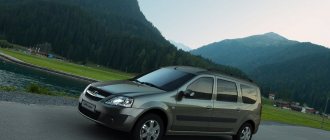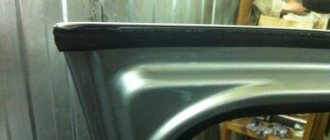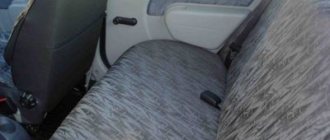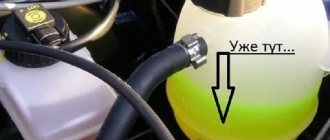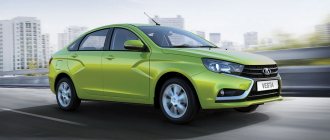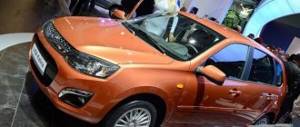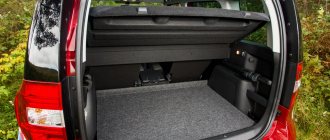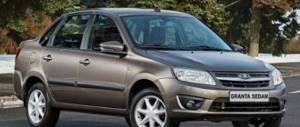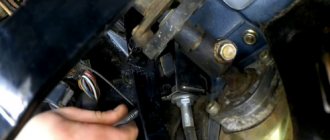Main technical characteristics
The premiere of the three-volume Lada Granta car took place in Moscow in the summer of 2011.
Assembly began in October of the same year. In fact, Granta became a replacement for three outdated models of the AvtoVAZ line, including 2107, Samara and Kalina. It was on the basis of Kalina that Granta was created, although the latter eventually received over 400 original components. In 2014, the model underwent a planned facelift, which largely affected the front part of the model. And in August last year, the premiere of a significantly updated version took place.
Overall dimensions allow Granta to be classified as a subcompact model, based on the European classification. This is confirmed by the corresponding overall dimensions:
- length 4260 mm;
- width 1700 mm;
- height 1500 mm;
- wheelbase 2476 mm;
- ground clearance or ground clearance 160 mm;
- curb weight from 1075 kg.
For Russian consumers, Granta is offered with 3 naturally aspirated engines. But we will talk about them a little later.
Lada Granta is built on a front-wheel drive architecture, where the engine is located transversely. In front there is a McPherson spring independent suspension, complemented by an anti-roll bar. At the rear there is a semi-independent spring-lever type suspension.
To compare Renault Logan cars and the domestic Lada Granta model, sedan cars in their current appearance, that is, after restyling, will be taken as a basis.
The Renault Logan belongs to the European B-class and has a front-wheel drive platform. The machine is aimed at a wide range of consumers, due to its minimum cost and maximum capabilities. This is exactly how the French developers describe their creation.
The second generation debuted first under the name Dacia Logan, and began production with the Renault logo in 2013. The new product appeared in Russia in 2014. Since July 2020, a restyled version has been available to us, which is precisely what is being considered in this comparison between two popular representatives of the budget class.
If we talk about overall characteristics, then Logan has the following figures:
- length 4346 mm;
- width 1733 mm;
- height 1517 mm;
- wheelbase 2634 mm;
- ground clearance 155 mm;
- curb weight 1106-1156 kg.
The Frenchman surpasses its more compact rival in this component, although it also belongs to the subcompact car segment.
Renault Logan is built on the basis of the M0 front-wheel drive architecture, where the engine is mounted transversely. Moreover, in the second generation, a large amount of high-strength steel was used for the body. There is an independent McPherson suspension at the front, and a semi-independent beam at the rear, complemented by hydraulic shock absorbers. Anti-roll bars are available front and rear.
Exterior of the French Logan and domestic Grant
Let us immediately note that there is no point in comparing these Lada Granta or Renault Logan cars with representatives of more expensive and prestigious segments, because one cannot expect dizzying characteristics and capabilities from our rivals. Both Granta and Logan are suitable for such clients who do not have a thirst for chasing status, prestige and high cost.
For its market niche, Lada turned out to be a very successful and balanced product, having managed to acquire enviable popularity since 2011. This modification is chosen not only by pensioners, but also by practical young people. Thanks to the wide range of colors of the “Russian” body, everyone will be able to choose the best option for themselves according to their taste. The interior decoration is made well and without much luxury for the sake of maximum practicality.
Regarding Logan, let’s say that it was introduced to the market earlier than the Russian model (in 2005), and already in 2014 it experienced its generational change. The appearance of the “Frenchman” is characterized as more restrained and closer to the classic. The balance of consumer properties contributed to wide popularity among representatives of different social classes.
Today the planet is experiencing a financial crisis, so saving this resource is more relevant than ever. When buying a car in such conditions, each future owner strives to find the most balanced option in terms of price and quality. The cost of a basic Lada reaches 230 thousand rubles. If we compare, the “French” in its minimum configuration will require a significantly larger amount - 330-350 thousand rubles. Here, as we see, Grant has a significant advantage.
Although many argue that appearance is not the main thing, when choosing a car it is difficult to agree with such a position. First, a potential buyer looks at the appearance. If you like the car, the further process of studying all the features, characteristics and other parameters of the model is already underway.
Therefore, when comparing two cars, when determining which is better to choose - Lada Granta or Renault Logan, the exterior will play an important role.
The restyling of the four-door sedan in the form of the Lada Granta clearly benefited the car. The signature X-design from the Tolyatti automobile plant allowed the model to get an original front end. As a result, the car began to look much more modern, more interesting and attractive. The proportions are precisely adjusted, there is no imbalance observed. The car definitely does not cause any discomfort or irritation.
Granta looks best from the front, which is due to the use of X-style. The car boasts a slanted front optics, a large logo, and a chrome boomerang that covers a solid bumper and allows you to visually connect the radiator and false radiator grille. But if you look at Granta from other sides, there will be no such emotions.
The Granta's exterior is still more aimed at a young audience than its opponent, Renault Logan. The Frenchman was mercilessly criticized for the appearance of the first generation. After the generation change, the situation changed for the better, but there were still many reasons for criticism.
Interior
It is impossible to give high marks for the interior decoration of Logan and Granta. The Russian sedan widely used hard and cheap plastic, complemented by silver decor. But this does not help the situation.
Salon of Lada Granta
If you look at the Lada Granta passport, you can see a 5-seater layout. But this is only on paper. In fact, a comfortable position on the rear sofa is available only for 2 people. Moreover, tall and large people will not be particularly comfortable here, since there is a lack of space in the knees and above the head. At the same time, the sofa was made very comfortable and with the correct anatomical shape.
The front seats have decent lateral support and a wide range of adjustments, if you take the top-end configuration.
But the Granta’s trunk failed to even surpass the luggage compartment of today’s competitor in its performance, since not every automaker is ready to offer 480 liters in a subcompact. Moreover, the rear sofa can be folded and you get an almost perfectly flat floor.
Salon Renault Logan
Renault Logan looks more interesting inside than outside. More modern interior solutions, stylish components, and a pretty good multi-function steering wheel are used here. Ergonomics are at a decent level, everything is arranged as it should be. I don't want to move or displace anything. The center console is designed in a minimalist style, but it can accommodate a large 7-inch multimedia touch display.
Logan's finishing materials are not significantly more expensive than Granta, but they are of better quality and more pleasant to the touch. The front seats received pronounced lateral support and excellent lumbar support. There is also a wide range of adjustments, plus heating. The second row has enough space for 3 adult passengers. But the sofa is flat, its level of comfort is noticeably inferior to the sofa on Granta.
The luggage compartment of the French sedan is designed for 510 liters. Moreover, here, like the Granta, there is a full-size spare tire in the underground.
About the behavior of these cars on the road
One of the most important criteria when choosing a car is the engine in combination with the gearbox. Moreover, in the case of budget cars, buyers primarily do not look at maximum power. They are much more interested in reliability, efficiency and good dynamics.
Quite an interesting point on which you can compare Renault Logan and Lada Granta.
Lada Granta engine
Let's start with the Russian representative. There are 3 naturally aspirated engines with 4 cylinders available. Moreover, each engine is in-line and has a volume of 1.6 liters.
- The basic one is an 8-valve power unit with 87 horsepower and 140 Nm of torque.
- The middle one in the hierarchy is a 16-valve engine with 98 horses and a torque of 145 Nm.
- The top one is a 16-valve engine with 106 horsepower and 148 Nm of torque.
By default, Lada Granta is equipped with a standard front-wheel drive transmission and a manual gearbox. For the 98 horsepower engine there is a non-alternative 4-speed automatic transmission. If we take the Granta with the most powerful engine, then the buyer gets the right to choose between a manual transmission and a 5-speed robot.
Depending on the configuration, the car can accelerate from 0 to 100 kilometers per hour in 10.5-12.4 seconds. The maximum speed varies from 167 to 183 kilometers per hour.
In the combined cycle, Granta consumes from 6.6 to 7.6 liters of fuel for every 100 kilometers traveled.
Now I wonder how the French public sector Renault Logan will be able to respond to this.
Engine Renault Logan
There are 3 engines available for Renault Logan in Russia. The interesting thing here is that they are all four-cylinder and, as in the case of the Granta, have the same volume of 1.6 liters.
- The standard and youngest engine is an 8-valve engine with a power of 82 horsepower and a torque of 134 Nm.
- Next in the hierarchy is a 16-valve unit with 102 horsepower and 145 Nm of torque.
- The top model for the Renault Logan is considered to be a 16-valve internal combustion engine with 113 horsepower, and the torque here is 152 Nm.
Technical characteristics of compared models
The engines of the compared sedans are 1.6 liters in volume. But with Granta you can choose between several power units, 8-valve, 82 and 87 hp. With. and 16-valve for 98 and 106 liters. s, it is also possible to install an automatic transmission for 30,000 rubles. Logan only has a 5-speed manual. As for the dynamics of the Grant, even with an 87-horsepower engine it is quite normal and is not inferior to that of the Logan, which has more horses under the hood.
This happens because the VAZ engine reaches maximum power at a lower number of crankshaft revolutions. One of the disadvantages of Renault Logan, which ordinary drivers point out, is the thin metal of the body on Russian-assembled cars (it is of better quality in Romanian ones). Another drawback is fuel consumption, one liter more than the Granta. Nevertheless, the French sedan with Romanian roots has earned a reputation as a reliable car with an almost indestructible chassis.
Security Settings
Let us remind you that for comparison we present the new or, more accurately, updated Lada Granta, as well as the second generation Renault Logan. The results of safety tests of previous generations and pre-restyling versions are not taken into account.
Renault Logan has several configuration options, but each of them offers a wide list of systems and components that affect active and passive safety. If you want the maximum set, then you need to take the top versions.
Logan cars are equipped with high-quality front and side airbags, three-point seat belts in the front, and a body made of high-strength steel. All this allows you to get a budget, but very safe car, perfect for Russian consumers.
Lada Granta does not have the same high-quality body, which is why it is inferior to its competitor. A certain disadvantage is the fact that the Lada Granta, like other domestic models, does not pass crash tests of the European and international standard, which are Euro NCAP. Because of this, it is difficult to objectively compare the two cars based on these parameters.
Let's be honest, domestic cars have always lagged behind their main competitors in terms of safety indicators. There have been no significant changes or improvements in the case of Granta. Even after restyling. But that doesn't mean it's a completely unusable car. No, it has airbags, a strong frame, collision resistance, various electronic systems, and so on.
Security Logan and Grants: differences between systems
Let us remind you that for comparison we present the new or, more accurately, updated Lada Granta, as well as the second generation Renault Logan. The results of safety tests of previous generations and pre-restyling versions are not taken into account.
Renault Logan has several configuration options, but each of them offers a wide list of systems and components that affect active and passive safety. If you want the maximum set, then you need to take the top versions.
Logan cars are equipped with high-quality front and side airbags, three-point seat belts in the front, and a body made of high-strength steel. All this allows you to get a budget, but very safe car, perfect for Russian consumers.
Let's touch on the suspension, ground clearance and other points
Structurally, the chassis of our today's competitors Lada Granta or Renault Logan are adapted to the characteristics of domestic roads. If the owner is interested in a long effective service life of the chassis, then he should worry about the correct approach to maintenance and operation. At first, both cars endure experiments in survivability in the pits, but then they will require surgical intervention in the chassis. The ability to overcome potholes is due to the enviable ground clearance of both cars.
The luggage compartments of our competitors LADA Granta or Renault Logan will please you with spaciousness, which serves for the benefit of practicality. Cars are equally well suited for trips to the country and for everyday activities.
Appearance
If in the previous generation the Sandero hatchback and the classic Logan sedan were completely different from each other, now from the front the cars are very easy to confuse with each other. If we talk about the differences, then you need to look at the cars in profile. Renault designers decided to focus specifically on the similarity of the Sandero to a crossover, which was emphasized by massive rear pillars and original stampings stretching from the rear door handle to the edge of the lamp. In combination with the slight slope of the almost horizontal roof, these elements make the Renault Sandero more massive, despite the fact that in reality the car is shorter than the Logan and does not exceed it in height and width.
But the Renault Logan sedan does not look so respectable. It also features large rear pillars and stampings on the sides of the body, but these design elements are lost against the backdrop of the massive trunk. Interestingly, the new sedan looks heavier than the previous generation Logan. This stylistic decision can be called controversial, since the Renault car has become more solid, but after the update, the appearance cannot be called particularly stylish and dynamic. Renault employees have achieved their goal - two cars built on a common platform look completely different.
From behind, the Renault Sandero does not look as distinctive as the previous generation car, since the massive vertical lights have given way to compact square-shaped lighting equipment. Now it resembles Suzuki, Toyota and even... Chery. Although overall it turned out very stylish - there is no hint of rounded shapes, which did not decorate the previous Sandero too much. There are very few changes in Logan compared to the previous generation - the lights have separate segments, and the bumper has increased in length. However, the Renault sedan remains completely recognizable due to the raised edge of the trunk and sloping rear window pillars.
Specifications
| Car model: | Renault Sandero | Renault Logan |
| Manufacturer country: | Romania (Assembly - Russia) | Romania (Assembly - Russia) |
| Body type: | Hatchback | Sedan |
| Number of places: | 5 | 5 |
| Number of doors: | 5 | 4 |
| Engine capacity, cc: | 1598 | 1598 |
| Power, l. s./about. min: | 102/5750 | 105/5750 |
| Maximum speed, km/h: | 180 | 180 |
| Acceleration to 100 km/h, s: | 10,5 | 10,5 |
| Type of drive: | Front | Front |
| Checkpoint: | 5 manual transmission | 5 manual transmission |
| Fuel type: | gasoline AI-95 | gasoline AI-95 |
| Consumption per 100 km: | In the city 9.4 / Outside the city 5.8 | In the city 9.4 / Outside the city 5.8 |
| Length, mm: | 4080 | 4346 |
| Width, mm: | 1757 | 1733 |
| Height, mm: | 1523 | 1517 |
| Ground clearance, mm: | 155 | 155 |
| Tire size: | 185/65 R15 | 185/65 R15 |
| Curb weight, kg: | 1104 | 1127 |
| Total weight, kg: | 1560 | 1545 |
| Fuel tank volume: | 50 | 50 |
We recommend: Which car is better - Nissan Almera or Renault Logan
Maintenance and repair
Someone will say that since the Lada Granta is a Russian car, it will be much cheaper and easier to maintain than a car of a foreign brand.
And this is a fairly common misconception. Both cars are, by definition, budget-friendly, and there is no talk of any expensive maintenance here. For AvtoVAZ, one of the key aspects of successful sales was to provide customers with an appropriate level of service, availability of spare parts and the ability to carry out repairs themselves.
Although not perfect, the enterprise coped with its tasks. Spare parts for Granta are very easy to find; they are quite cheap compared to many competitors, but not Renault Logan. Carrying out independent repairs will also not be difficult when you have at least minimal experience and some basic knowledge.
But all this applies to domestic cars. It would be strange to produce Russian cars in Russia for which expensive spare parts or unavailable components are offered.
Despite its French roots, Renault Logan also managed to become a people's car in Russia. It is highly valued and loved because the car is as reliable and trouble-free as possible. Granta is still inferior in this component, since the car from the factory has a number of defects that appear a short time after the start of operation. Logan is also not perfect, but it looks preferable to its competitor.
Although such a comparison initially gives a certain advantage to the Lada Granta, even here the Renault Logan managed to show its best side. For Logan, spare parts are also cheap, the car easily accepts non-original parts, and can work with not the highest quality consumables. Draw your own conclusions about which car is better and more profitable to buy for use in Russia.
Let's sum it up
Now we can say a few final words regarding what to choose when the Renault Logan and Lada Granta cars are standing in front of you.
Logan has been present on the Russian market for more than 10 years. This is a decent amount of time for consumers to note all the strengths and weaknesses of the car. But this is objectively not enough to decide what to buy for yourself - Logan or Granta. After all, the same conclusions are needed regarding the Russian opponent. And then it will become clearer whether to buy a Frenchman or support the domestic auto industry.
If you need a work car for a reliable and comfortable ride, it is better to give preference to the Renault Logan. When you properly care for it and operate it correctly, major repairs will be required at least after 300 thousand kilometers. There are examples when Logan passed all 500 thousand. Yes, conclusions are drawn largely based on the history of the first generation. But the second generation retained the main strong qualities of its predecessor, plus in some places it became better.
Renault Logan does not use complex designs, multi-level schemes or additional expensive parts. All this has a positive effect on the service life of the machine. Even if something in Logan breaks, it will be quite cheap to restore, repair or replace it.
Currently, Logan is considered the most reliable car in the budget segment. Therefore, many people do not even have doubts about what is better to buy - Logan, Granta or some other car. In their understanding, you cannot buy anything better for that kind of money than the French model. Logan is cheap, but built to last. Yes, there are minor assembly flaws, but this does not spoil the overall impression of the car.
In defense of the Lada Granta, we can say that for the Russian auto industry it is a kind of breakthrough, an exit to a higher quality level. The demand for the model is largely due to its affordable price, which is lower than that of its competitor. Plus, there is a solid luggage compartment, a good level of comfort in the interior and a nice design. Consumer expectations regarding accessible service were confirmed.
It’s not for nothing that Granta is actively used as a first car for beginners, purchased for taxi services and used as a car for work, trips to the country, fishing, etc. Reliability and comfort are at a decent level, and fuel consumption is also low.
Today, representatives of the budget market segment of cars have rapidly burst into the life of the average person. Although compared to expensive brands, there is some inconvenience associated with cases when the dealer does not have a modification you like, but such a car is not capable of burdening the future owner with expensive repairs and maintenance.
Compare engines of domestic cars and foreign cars
The engine in the most budget version of the first Logan is 1.4 liters, eight-valve with a capacity of 75 hp. With. – in terms of torque, it’s not much better than the old VAZ “classic”. Of course, there is enough power for a quiet ride, but staying ahead of passing cars on the highway with such an engine is not such a simple matter.
Economy is also not in Renault's favor. The engine of the previous generation model is 1.4-liter with a power of 75 hp. pp., consumes 7 liters of fuel on average. Logan has approximately the same figure with a 4-speed automatic transmission, but with a 16-valve 1.6-liter engine producing 103 hp. With. In the combined cycle, its consumption is 7.1 liters of gasoline per 100 km.
Second-generation Logan models are available only with manual transmission; only two engines are expected for them:
- 82-horsepower eight-valve engine.
- 102-horsepower sixteen-valve engine.
Their fuel consumption is approximately the same - about 7.1-7.2 liters per 100 km.
The following engines are offered for Priora:
- 87 l. s., 1.6 l, 8-valve.
- 98 l. s., 1.6 l, 16-valve.
- New 106-horsepower, 1.6-liter with dynamic supercharging.
Their fuel consumption figures are similar, but the engines of domestic cars are more powerful, and they also have better torque.
Despite this, unlike the same Priora, the old Logan can be officially filled with 92-octane gasoline, while for modern Lada cars the manufacturer recommends using only 95-octane gasoline. And the “French” will be able to go further at one gas station - after all, 50 liters of gasoline can be poured into its fuel tank, unlike the Lada, whose tank volume is only 43 liters.
